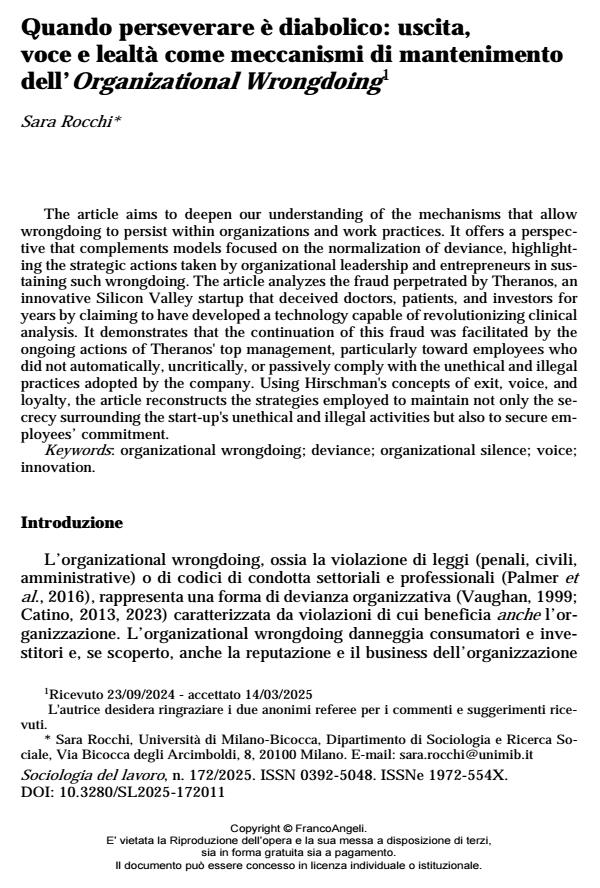Quando perseverare è diabolico: uscita, voce e lealtà come meccanismi di mantenimento dell’Organizational Wrongdoing
Titolo Rivista SOCIOLOGIA DEL LAVORO
Autori/Curatori Sara Rocchi
Anno di pubblicazione 2025 Fascicolo 2025/172
Lingua Italiano Numero pagine 18 P. 225-242 Dimensione file 197 KB
DOI 10.3280/SL2025-172011
Il DOI è il codice a barre della proprietà intellettuale: per saperne di più
clicca qui
Qui sotto puoi vedere in anteprima la prima pagina di questo articolo.
Se questo articolo ti interessa, lo puoi acquistare (e scaricare in formato pdf) seguendo le facili indicazioni per acquistare il download credit. Acquista Download Credits per scaricare questo Articolo in formato PDF

FrancoAngeli è membro della Publishers International Linking Association, Inc (PILA)associazione indipendente e non profit per facilitare (attraverso i servizi tecnologici implementati da CrossRef.org) l’accesso degli studiosi ai contenuti digitali nelle pubblicazioni professionali e scientifiche
Obiettivo dell’articolo è contribuire alla comprensione dei meccanismi che permettono la persistenza del wrongdoing all'interno delle organizzazioni e nelle pratiche lavorative. La prospettiva offerta, complementare ai modelli incentrati sulle dinamiche di normalizzazione della devianza, mette in evidenza il ruolo dell’azione strategica del vertice organizzativo e dell’imprenditore nel sostenere il wrongdoing. L’articolo analizza la frode compiuta da Theranos, startup innovativa della Silicon Valley, che per anni ha ingannato medici, pazienti ed investitori affermando di aver inventato una tecnologia in grado di rivoluzionare le analisi cliniche. L’articolo mostra che il proseguimento della frode fu reso possibile dall’azione esercitata in modo continuativo dal vertice di Theranos, in particolare su quei dipendenti che non si conformavano automaticamente, acriticamente e passivamente alle pratiche lavorative non etiche e illegali adottate dalla startup. Utilizzando i concetti di uscita, voce e lealtà di Hirschman, l’articolo ricostruisce le strategie utilizzate per assicurare non solo il mantenimento del segreto circa le attività non etiche/illegali della startup, ma anche l’impegno dei dipendenti.
Parole chiave:organizational wrongdoing; devianza; organizational silence; voce; innovazione.
Sara Rocchi, Quando perseverare è diabolico: uscita, voce e lealtà come meccanismi di mantenimento dell’Organizational Wrongdoing in "SOCIOLOGIA DEL LAVORO " 172/2025, pp 225-242, DOI: 10.3280/SL2025-172011